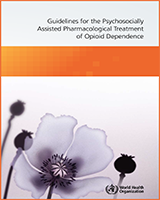All rights reserved. Publications of the World Health Organization can be obtained from WHO Press, World Health Organization, 20 Avenue Appia, 1211 Geneva 27, Switzerland (tel.: +41 22 791 3264; fax: +41 22 791 4857; e-mail: tni.ohw@sredrokoob). Requests for permission to reproduce or translate WHO publications – whether for sale or for noncommercial distribution – should be addressed to WHO Press, at the above address (fax: +41 22 791 4806; e-mail: tni.ohw@snoissimrep).
NCBI Bookshelf. A service of the National Library of Medicine, National Institutes of Health.
Guidelines for the Psychosocially Assisted Pharmacological Treatment of Opioid Dependence. Geneva: World Health Organization; 2009.

Guidelines for the Psychosocially Assisted Pharmacological Treatment of Opioid Dependence.
Show detailsThese guidelines have been developed in response to the resolution Guidelines for psychosocially assisted pharmacological treatment of persons dependent on opioids of the United Nations Economic and Social Council (ECOSOC). The resolution invited the World Health Organization (WHO), in collaboration with United Nations Office on Drugs and Crime (UNODC), “to develop and publish minimum requirements and international guidelines on psychosocially assisted pharmacological treatment of persons dependent on opioids, taking into account regional developments in the field, in order to assist the member states concerned” [1].
These guidelines are intended to be read by those involved in providing psychosocially assisted pharmacological treatment of opioid dependence at any level. Chapter 2 explains how the guidelines were formulated, and Chapter 3 provides background information on opioid dependence. Chapters 4–6 are directed, respectively, at the three broad groups for whom this document is intended:
- policy makers and administrators who make decisions on the availability of medicines, and on the structure and funding of services in countries or in subnational health administrative regions
- managers and clinical leaders responsible for the organization of specific health-care services, and for the clinical care those services provide
- health-care workers treating patients within the health-care system.
National and regional programmes, and treatment guideline groups may wish to use this document to assist in the development of locally adapted guidelines.
The clinical questions addressed by these guidelines were developed in consultation with clinicians and academics from various countries involved in the management of opioid dependence. The questions addressed by these guidelines can be summarized briefly as:
- What medications should be used for the management of opioid dependence and withdrawal? Further questions related to this issue are:
- ♦
Should preference be given to opioid agonist maintenance treatment, detoxification or antagonist treatment?
- ♦
Which medications should be used for each approach?
- ♦
How should medications be administered (optimal dose, level of dosing supervision, etc.)?
- What level and type of psychosocial support should be provided to opioid-dependent patients?
- What specific treatment should be offered to specific groups (e.g. people with human immunodeficiency virus (HIV) and pregnant women)?
- What are the minimal standards for provision of treatment for opioid dependence?
The recommendations in the guidelines operate at three levels:
- treatment systems at national and subnational levels (policy, legislation, funding, regional and country planning) (see Chapter 4)
- treatment programmes (methods of organization and provision of care) (see Chapter 5)
- treatment of the individual patient (see Chapter 6).
Recommendations made at the level of the individual patient are based on systematic reviews of clinical trials, summarized in Annex 1. Recommendations at the other two levels are based on a range of evidence, including extrapolation of clinical trial data by experts in the guidelines development group, epidemiological studies and the principles of medical ethics.
The medications considered in these guidelines are methadone, buprenorphine, naltrexone and adrenergic alpha-2 agonists (clonidine, lofexidine and guanfacine). Although other medications show promise in the treatment of opioid dependence, they have not been included in these guidelines because there is insufficient evidence to make a full analysis of their effectiveness; thus, including them would significantly increase the complexity of the guidelines. A brief description of the pharmacology of these medications is included in Annex 4.
The aims of these guidelines are to:
- reduce global barriers to the effective treatment of opioid dependence
- contribute to the development of evidence-based and ethical treatment policies for opioid dependence
- contribute to improvement of the quality of pharmacological treatment of opioid dependence
- facilitate implementation of effective treatment policies and programmes for opioid dependence.
The guidelines are not:
- a comprehensive guide to opioid dependence or its treatment
- a replacement for clinical judgement
- a description of local regulations for the provision of opioid dependence treatment.
The guidelines cover not only opioid dependence, but also treatment of opioid overdose and opioid withdrawal.
- Scope and purpose - Guidelines for the Psychosocially Assisted Pharmacological T...Scope and purpose - Guidelines for the Psychosocially Assisted Pharmacological Treatment of Opioid Dependence
Your browsing activity is empty.
Activity recording is turned off.
See more...